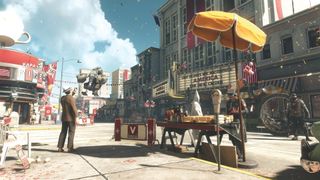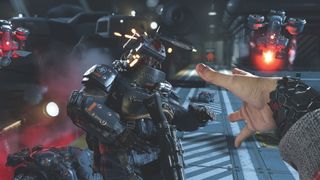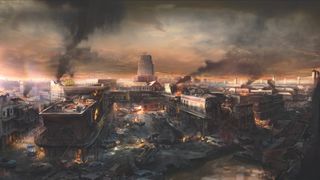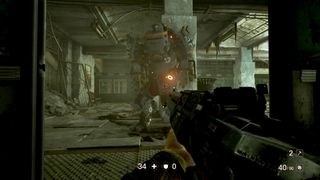MachineGames on Wolfenstein 2's development, controversy and what’s next: "we always planned this as a trilogy"
Last year was full of huge games, but Wolfenstein 2: The New Colossus managed to stand out thanks to its impressive shooting and insane story – there’s no doubt that it’s one of 2017’s biggest releases. But just what went into making it as bombastic as it is, and where does the series go next from here? How do they keep dialling up the madness to top that ending?
We sat down to chat with Jerk Gustafsson, executive producer at MachineGames, about how far it’s come from the first game and the challenges that emerge when developing a highly anticipated, blockbuster game. They might make it look easy, but there’s a lot of work going on behind the scenes to make sure the game turns out great when it reaches players’ hands.

OXM: How does it feel now that the game is in people’s hands?
Jerk Gustafsson: It’s a bit scary of course – it always is, when you have been working on something for a few years. You have invested a lot of time in it, so you’re always nervous about it. But I really do feel that we have a very strong and a very good game.
OXM: What kind of reaction did you think you’d get?
JG: Over our entire careers, ever since Enclave and Riddick and all those games, we have focused a lot on the narrative and also the first-person experience, and I think that in particular will be what people highlight now as well. The storytelling, of course, that is a big, big issue and the other thing is the shooting aspect – the way it feels when you move around with a weapon in your hand. I think we have made a lot of great improvements to that since our previous game and within that field, so I at least hope they will be the talking points.

OXM: What is it that makes it feel significantly different to the first one?
Sign up to the 12DOVE Newsletter
Weekly digests, tales from the communities you love, and more
JG: I think the big step for us is to use the full body for the player. For The New Order – and what many games do – is have a floating model that you play with. But for this game, we moved over to a full body, similar to what we had in the Riddick games, so you’re always physically present in the world, which I feel makes it a lot more fluent and seamless. When you are going to perform certain tasks, certain actions, whether you fall down, you climb a ladder, whatever it is, it’s always the full body that is part of the experience. So it feels a little bit more integrated and seamless, and I think that’s a big step for us.
On the gameplay side that’s more noticeable too – we allow players now to dual-wield different weapons in each hand. In the previous game we’d only allow weapons of a similar type, but as an example, now you can sneak around with a silenced handgun in one hand and a fully auto shotgun in the other. So for those type of things, we have put a lot of focus on it to make sure that selection and movement with those two weapons are fluid.
OXM: Is there anything that didn’t quite make it into the game because you were forced to tone it down?
JG: Not really. I mean it’s always been somewhat controversial since we are fighting against the Nazis, but we really haven’t... The storytelling and the way we are writing stories, that doesn’t differ in any way from what we did with The New Order. People seemed to really like the story, so we have turned it up a little bit, I think it is a little bit more crazy and maybe a little bit more controversial but in that way we give ourselves freedom in how we tell the story. And of course, the entire story’s about going back to the home country, back to the United States and liberating it, like you say, from the Nazis, so of course that contributes as well to the controversy.

OXM: How did you go about getting that balance between fantasy and history to make it feel real?
JG: The main reason that we took it in this direction with alternative history is that it would give us a little bit more freedom in terms of storytelling, but also in terms of what type of gameplay elements we added. We could be a little bit more free when it comes to using sci-fi and enemies and weapons, and introducing robots as an example. For us that was the main reason for moving over to the alternative history – to give us a little bit more freedom in what we could do in terms of technology and those types of elements.
OXM: The series is known for being quite OTT. How did you go about topping the previous one?
JG: We haven’t really held back anything, so in terms of storytelling we’ve been pushing it in a way that we feel really dials it up.

OXM: What have been your greatest challenges making this game?
JG: When you develop games nowadays, the time it takes... the development periods are so long, so we are very careful that when we lay the foundations, we stick to them. But you always have to be flexible – over two-and-a-half to three years, a lot of things change, not only on the technical side but also in a lot of other respects. New people are coming in, some people may leave – there’s always those types of challenges, there’s so many things that change when you’re in development.
And since we are using an updated version of id Tech 6 we have encountered a lot of challenges in terms of tech in general; the new animation pipeline and the new script system. All of those things have been providing lots of extra challenges, but also fun challenges because they allow us to make the game that we really want to make, and make sure that we can meet our ambitions from where we start.
OXM: What’s your proudest moment?
JG: I think that usually is at the end. Also, [I’m really proud of] the team we have, since we have a core group that we have been working with for so long. We have always been good at making sure things get together in the end, and we’ve seen a lot of progress here in the last month.
And when you see all of that coming together, even though it’s a hectic and stressful period with a lot of work, it’s also the most fun and rewarding time, because when you see all these things coming together, you feel great. You get that extra motivation and that extra push to finish the game, and of course you’re also very proud not only of the work you have done and the product that has come together, but also you become very proud of the team and all the effort that the team puts into it. Yeah – this one especially has been extremely rewarding.

OXM: Now that the game is out, what’s your next move? Is it time for a little break?
JG: I think when you put the pen down on something, then at that moment you’re at your most eager to get started on something new, because you have so many new ideas and new things you want to do. Of course, people will have some rest and the team will have well-deserved time off, but we are also eager to get started on something new and continue to work on this Wolfenstein IP that we have come to love so much. Then what we’re doing now is some DLC work.
OXM: What are your plans for the rest of the Wolfenstein series? How far along is Wolfenstein 3?
JG: Even from the very beginning – when we set out to start work on The New Order – we had always planned this as a trilogy, and this is the second game. Whatever happens in the future we will have to see; it depends on how well the game does – but we have always planned for a trilogy and we as a team would love to continue to work with Wolfenstein. Still, you never know what will happen.

OXM: So we guess the third game is already in some form of planning stage?
JG: No – we have focused on this game and there are always ideas you have floating around and there are things that you want to do but nothing really concrete. The focus has been this, and now we are focused on the Xbox One X release as well, and then we will go onto some DLC stuff from there, and then we’ll see.
OXM: How have you found working with the Xbox One X?
JG: It’s a super powerful machine and the game runs really, really well – it looks fantastic on the Xbox One X. The focus has been to make sure that we can present the game in the best possible way and use the console and the power that the new console provides. And of course, everything from lighting and graphics overall – in terms of visual quality it will be a lot closer to the high-end PCs than the regular consoles.
OXM: Do you think the Xbox One X will change the gaming industry?
JG: Yeah – I hope so at least. If you have the possibility to develop and deliver games that run in 4K resolution and look that fantastic, of course you want to take that opportunity. It will set a new standard for games moving forward.
This article originally appeared in Xbox: The Official Magazine. For more great Xbox coverage, you can subscribe here.
Daniella is a freelance consultant, writer, and editor, who was formerly deputy editor at Official Xbox Magazine before its closure. Her words have appeared on the Guardian, Eurogamer, PC Gamer, and GamesRadar, among others. She's a Final Fantasy 14 aficionado.












